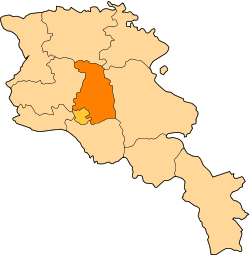Byureghavan
Coordinates: 40°18′53″N 44°35′37″E / 40.31472°N 44.59361°E
| Byureghavan Բյուրեղավան | |
|---|---|
|
View from Byureghavan | |
 Byureghavan | |
| Coordinates: 40°18′53″N 44°35′37″E / 40.31472°N 44.59361°E | |
| Country | Armenia |
| Marz (Province) | Kotayk |
| Established | 1945 |
| Government | |
| • Mayor | Hakob Balasyan |
| Area | |
| • Total | 4 km2 (2 sq mi) |
| Population (2009) | |
| • Total | 8,400 |
| • Density | 2,100/km2 (5,400/sq mi) |
| Time zone | UTC (UTC+4) |
| Website | official website |
Byureghavan (Armenian: Բյուրեղավան) is a town in the Kotayk Province of Armenia. It is located 16 kilometres (10 miles) northeast of Yerevan, and 25 kilometres (16 miles) south of the provincial center Hrazdan. In 2009, the estimated population of the town was 8,400. It covers an area of 4 square kilometres (1.5 square miles). The rural communities of Nurnus and Arzni form the northern and southern borders of the town respectively.
Etymology and history
The name of Byureghavan is derived from the Armenian words of byuregh (Armenian: բյուրեղ) meaning glass, and avan (Armenian: ավան) meaning settlement. The town was founded in 1945 as a small settlement named Arzni banavan (Arzni labours settlement) to accommodate the workers of the nearby bottle manufacturing plant. In 1974, the community was given the status of urban-type settlement and renamed Byureghavan, after its well-known cut glass factory.
In 1994, Byureghavan had received the status of a town.
Industry
Between 1960 and 1980, the town of Byureghavan and the surrounding localities became a very important industrial centre in the Armenian SSR, accommodating many large plants. Nowadays, the town is home to Glass World company (est. in 1968 as Arzni Glass, laterly known as Arm cut glass), Almaqar stone-processing enterprise (est. in 1971 as Nurnus), Sunenergashin reinforced concrete columns manufacturing company (est. in 1973 as Armenerga net-build), BML Arzni mineral water factory (est. in 1925 as Arzni, relocated to Byureghavan in 1974), Byuregh Alco brandy and wine factory (est. in 1996), Varat stone crushing company and many other plants.
Demographics and culture
The population of the town is mainly Armenian with minor Russian, Yazidi, Assyrian and Greek communities.[1]
The town is home to several art schools and academies, a house of culture, as well as a football stadium with a capacity of 1,000 seats.

